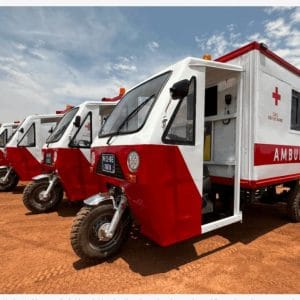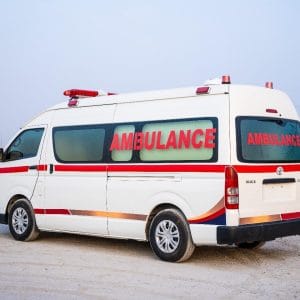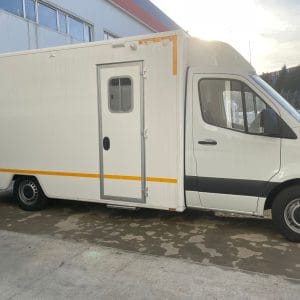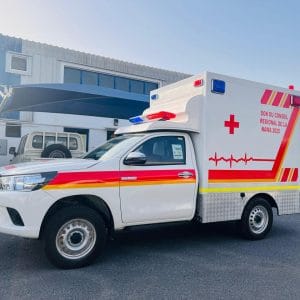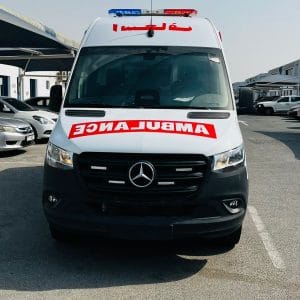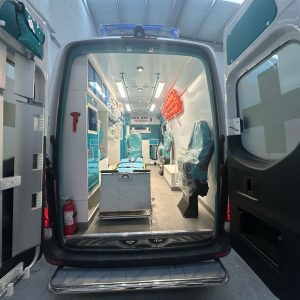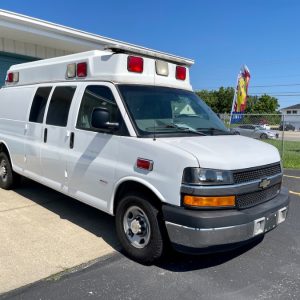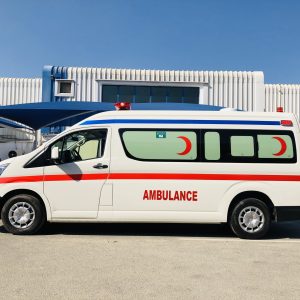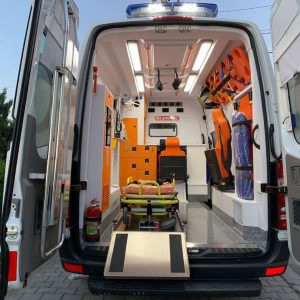1. Introduction
Type 1 Ambulances are vital emergency vehicle that is the core of emergency medical services. There are multiple types of ambulances that serve in different roles in emergency medicine. This essay is focused on Type 1 ambulances, also known as the ‘calling/response’ ambulances. Type 1 ambulances are built using a truck cab for the driver and ambulance box. These ambulances can provide everything from Advanced Life Support care to Neonatal Intensive Care Units. This essay aims to discuss who leads the way in Type 1 ambulance manufacturing and the innovations they have made. The team has broken down the basic structure of design and performance by manufacturer to figure out the differences in features based on manufacturers. We have gone into past literature and data and analyzed why a Type 1 ambulance would be the best choice for the patient and community served by the ambulance. The design section identifies features that each Class 1 vehicle has and aligns them with standards in the field. This essay looks at the communities ambulances are in, not just urban, but also rural and suburban, and how ambulances are used in the communities they serve. This essay does so to understand the ever-evolving needs that patients have in the healthcare system. If you have ever been a patient in an emergency, what does a patient need to feel safe in the ambulance and to know that they are cared for? If you need help, you need to know the manufactured choices the ambulance community has made.
It was decided that a Type 1 ambulance would be the best choice for the vast majority of patients and therefore should be explored. I want to show some of the best trucks in design and performance by ambulance makers in the United States. I also intend to begin exploring different ways to measure which ambulances the community’s patient population feels work the best for them. It is important for communities to understand with great clarity what design is, what performance is, and who the leaders among manufacturers are. This working explanation gives definitions of an ambulance, its role, its audience, and looks at color choices for why an ambulance is manufactured in that way. An ambulance’s role is not only to protect people inside it (including EMS providers) but also to provide care inside the vehicle on the way to the hospital. The ambulances that a community chooses for its emergency medical services should be selected not only by the community but also by the patient population, as they are given the best chance at life. When an ambulance is needed, it is a serious time; lives are forever changed. What is behind the ambulance in which a patient rides is nearly as important as the people inside it.
2. Chapter 1: Overview of Type 1 Ambulances
Type 1 ambulances are those that are classified as F-450 or larger. Other types of ambulances include Type 2 ambulances, which are pickup chassis with a module in the back, and Type 3 ambulances, which are van cutaway chassis with a module in the back. Type 1 ambulances are unique in that they are built onto a small truck chassis that is then delivered to the manufacturer. The Type 1 ambulance manufacturer then completes the ambulance build to the specifications of the end user. These are different from other types of ambulances that are built as a complete vehicle at the chassis manufacturer’s factory. This nominally means that Type 1 ambulances are built to some of the highest standards, and for years they generally have been.
Type 1 ambulances are designed to last a long time in some very grueling conditions. They are built for speed and maneuverability. When it comes to patient care, these ambulances have the best-in-class room for gear and medical supplies and have the most room for medical crew access to the patient compared to other types of ambulances. Patients are transported on a cot that can be locked into the ambulance but also outside of the ambulance, allowing for the one cot to serve both purposes. Today’s top-reviewed Type 1 ambulance manufacturers stand out as top-tier vehicles in the industry through their innovations and as leading producers of wellness-focused, integrated, and quality ambulances. Regulatory information that informs these sections may be introduced, including one topic looking at regulations specific to patient care in an ambulance and another looking at what human factors are related to patient care. For context and to give real-world application of the information provided, case studies of cities that appreciate the use of Type 1 ambulances can be included. These case studies and statistics can be drawn from studies on the efficacy of Type 1 ambulances or stories told about ambulances featured in emergency response publications.
2.1. Definition and Classification
Type 1 ambulances are front-engine ambulances. If the vehicle has a van-type or box construction, the cab is positioned over or forward of the front axle, with a gross vehicle weight rating (GVWR) between 9,000 and 14,020 pounds. Type 2 ambulances are also van box-type ambulances; they have a GVWR of less than 9,000 pounds. Type 3 ambulances are mounted to a cutaway van chassis, such as a van front with a truck bed. The weight of the ambulance portion is added to the GVWR of the van, and they typically have a GVWR greater than 14,020 pounds. Defining the different types of ambulances is like finding that punctum that defines what makes a photograph distinctive. When we look at an ambulance that has been classified as Type 1, we see an ambulance that has been engineered from the ground up. Due to the exacting standards inherent in the federal specification, a Type 1 ambulance promises a certain standard of safety to minimize the risk of death or injury for patients and paramedics. To maximize functionality, every aspect of the vehicle has been designed to work together, and patients can be loaded or treated with minimal need to navigate tight spaces. Moreover, in the event of a vehicle crash, the deprivation of liberty inherent in the patient cage is non-existent, allowing quick extrication if necessary. Over the years, new federal ambulance specifications have required changes to the way ambulances are defined and classified.
2.2. Importance in Emergency Medical Services
The emergency medical services (EMS) system relies on a variety of ambulances to facilitate patient transport and response. As these vehicles respond to 911 calls, they are designed to primarily enhance response times and patient outcomes. These ambulances may be deployed in urban or rural settings for a variety of reasons. For instance, statistics indicate that they are employed on the nation’s roadways about 37 million times each year to respond to 911 calls and to facilitate hospital-to-hospital transfers of patients. Worldwide statistics also suggest that they may be deployed as a means of health transportation to transport nearly 60 to 80 percent of the patients who go to a hospital.
A growing concern for public health, officials, and first responders speaks to the changing nature of EMS calls from ground-based radiology responses to high-acuity enhanced 911 responses. Indeed, an interventional study demonstrated that when traffic collision victims in need of advanced trauma care were transported to the highest level trauma centers of care, it increased their chances of survival fourfold. Type 1 ambulances are used today because they can assist in an array of first responder disciplines. As radiology and at-scene response moves away from 911 and onsite, transport efficiencies increasingly matter. In such multi-disciplinary contexts as will be presented below, the WigWag will enhance provider safety and effectiveness.
When patients need transport, reduced on-scene time and quick and efficient patient extrication and packaging are vital. A population-based study showed that trauma patients with high ISS outcomes improved the faster a patient was transported from the scene to a hospital.
3. Chapter 2: Key Features and Components of Type 1 Ambulances
The most important feature of a Type 1 ambulance is how it is built. There must be a sturdy and strong base to withstand the constant movement and wear and tear caused by the weight of equipment and patients. Manufacturers are known for offering both Type 1 and Type 3 ambulances built on a custom chassis. Here, the chassis of a vehicle is completely custom-made. Alternative manufacturers build their own chassis specifically for first responder vehicles like ambulances. Customized chassis tend to cost more, which is why these Type 1s tend to cost more in general and are generally purchased by urban areas. The body and roof construction features built into Type 1 ambulances are designed to keep the interior safe and assist in treating patients.
Some Type 1 ambulances also include the use of compressed aluminum to help improve the body panel’s structure. While almost all designs feature a raised roof for additional headroom for workers and patient care, the one attribute that the designers must incorporate has to do with something that happens inside the vehicle — side roll. This refers to those cases in which the driver may need to make quick lateral movements in order to avoid a car or truck that doesn’t see the fire engine trying to turn into a parking lot. The last thing the patient in the back needs is to get jostled while in gear, especially in a critical transport emergency. Inside the ambulance, there are many aspects to take a look at, surrendering to mechanical and electrical components. For example, the availability of life-saving equipment within a Type 1 ambulance in a fast, direct, and efficient manner during an emergency situation ensures the most successful outcomes possible. Moreover, the built-in stretchers and designs for securing patients in transport are important. The newest is an electric-powered cot that allows the EMS professional to raise and lower the cot with the help of a button. The patient can remain undisturbed while the cot is being adjusted to the correct position for transport. Safety in a Type 1 ambulance includes aspects far beyond the availability of one of the highest safety ratings in the automotive industry. Compliance with a series of industry standards is addressed as well, most notably by ambulance standards.
3.1. Chassis and Body Construction
The previous section provided a list of materials utilized in the construction of Type I ambulances; however, for this document, the actual construction details are a trade secret, as the team has worked together developing this process to decrease the amount of welds on a typical ambulance design. What is known, though, is that, regardless of methods or materials used, because of the intense demand put upon an ambulance during emergency services and rescue, a durable, yet lightweight, material in construction is needed. Also, a final ambulance design is necessary, keeping weight at the front of the vehicle, which is loaded with medical equipment and limited on the rear due to the burial of the inpatient’s head. Standard steel, galvannealed steel, stainless steel, aluminum, and composite materials were all thought to be used in body construction. Common unibody vehicles such as cars and vans develop their strength from the roof and the floor and have a large number of seams confidently welded together to restrict vibration in the panel. Ambulances, though, rely on the frame and body and must have extremely good or no seams depending upon movement inside the patient in the vehicle for safety and customer satisfaction. This constrained the fixings applied, involving welds, rivets, adhesives, or some combination of them. In regard to the chassis, the best ambulance does not only begin with an exemplary platform; it must also be a safe one. The technological advances in the most modern chassis are preferred, especially when integrating patient safety into the vehicle. There can also be an intermediate chassis design that allows manufacturing to be altered for fabrication and design of an ambulance.
3.2. Medical Equipment and Technology
In equipping Type 1 ambulances as mobile emergency departments, various medical equipment and technology are needed to assist paramedics in providing the immediate care patients require in transit to the hospital and to save their lives. At the minimum, a Type 1 ambulance features a 12-lead defibrillator/monitor, companion monitors, mechanical chest compression devices, injection pump syringe, and mechanical resuscitators. Tools that help monitor the vital signs of transported patients and evaluate their critical and/or life support status generally operate in real time. Some of these tools are included in the 12-lead defibrillator/monitor and can provide their readings on the main monitor and companion devices, as well as information about the cardiac rhythm of the patient.
Each of the leading Type 1 ambulance manufacturers not only offers a different monitor as a standard but also provides additional measurements, which are of no less importance to monitor. In particular, one monitor is equipped with a CO2 monitor for EtCO2 analysis and non-invasive continuous blood pressure. Another monitor can provide input for a variety of parameters: Red Cell Volume, Oxygen Saturation, Carbon Monoxide, Methemoglobin, Blood Glucose, Respiration, Carbon Dioxide, Oxygen, and temperature. A different monitor sends all of the patient’s vital sign data to a cloud monitoring service, along with the 12-lead EKG, while also uploading data directly to the hospital’s Electronic Health Records during patient transport. Providing better communication among EMS crews or between emergency staff and doctors has become a recent paramount consideration with these last two developments. Telemedicine, connected and mobile Electronic Health Records, as well as workflows are discussed in the following paragraph.
4. Chapter 3: Leading Type 1 Ambulance Manufacturers
Chapter 3
Leading Type 1 Ambulance Manufacturers
3.1 Interest, Competition, and Collaboration
3.1.1 Manufacturer Interest in Chapter 3
Chapter 3 shifts our focus as readers from the vehicle bodies of accessible transportation thematic group to the leading (Type 1) ambulance manufacturers. It is important to understand the magnitude of what follows. Type 1 series ambulances are the premium units in the ambulance industry. They account for the majority of products built by ambulance manufacturers, assembled on crew cab chassis within their respective manufacturing plants. As observed in Chapter 1, they function as a diversity of vehicle bodies of accessible transportation. Manufacturers lead in design whether it be a narrow or a wide body, a top-mount or a flush-mount unit, a box with or without a raised roof, a traditional box design or cab-cut unit. Manufacturers are vertically integrated and assemble products rather than only fabricate them. Six primary manufacturers build over 70 percent of new Type 1 series ambulances. They have been a part of the EMS systems since the 1950s, earlier building a variety of commercial and client-specific chassis.
It is anticipated that ambulance bodies of accessible transportation are representative of the manufacturers that build them. These specific ambulance builders also happen to be stakeholders in the coalition. Each of the manufacturers provides an ambulance product that is appreciated by ambulance services and providers of emergency medical services. Each of the manufacturers had a great willingness to facilitate our work. These manufacturers find it gratifying that the diversity of new Type 1 series ambulances incorporates such a wide range of features that provide safety, ranging from occupant protection and patient care to performance in a diversity of geographical locations in the United States. We avoided labeling the profiles of these manufacturers as an industry survey, which one may equate with an electric industry trade journal. We have most likely not explored in this chapter the number of upfitters that mount ambulance boxes and shelters to stripped commercial chassis. We address the marketplace and the major manufacturers in section 3.2. The later section discusses the new or enhanced products that the manufacturers currently offer.
4.1. Manufacturer A: History and Background
4.1. Manufacturer A: History and Background
4.1.1. Introduction
Working in the ambulance manufacturing field for several years, Manufacturer A has seen a variety of milestones, evolutions, and game-changing innovations that have defined the market. Manufacturer A has a rich history starting in small-town America and evolving over the years into a key player in the marketplace. Through collaborations or partnerships, this manufacturer has introduced product solutions to the marketplace that significantly advanced Type 1 ambulance design. This resulting design in today’s industry forms a large majority of the Type 1 ambulance space. Manufacturer A has seen economic downturns, changes in sales strategies and ownership, and also a multitude of competitors join and exit the market throughout their years in business.
Manufacturer A has overcome and adjusted to the various challenges the marketplace has faced to continue to offer and provide value to their customer base. Other manufacturers have learned from Manufacturer A as well and adjusted their designs to stay competitive in the country. Over the years, Manufacturer A has seen varying opinions and discussions about their ambulances and chassis. These discussions have primarily focused on the sovereign rights, power of the gross vehicle weight rating, engine performance, battery issues, all patient access, lighting, drivability, and safety aspects of their vehicles. In the healthcare development context, technological innovations, particularly within the transportation industry, are critical in enhancing patient care and improving the effectiveness of the medical response. Type 1 ambulances are versatile vehicles and are the traditional design used in today’s ambulance industry.
4.2. Manufacturer B: Key Products and Innovations
Introducing the company’s flagship models, this section will provide an overview of the key products and innovations that have been developed and will go on to describe them in more detail, including the results of any relevant trials or studies that may have been conducted. The C1.2 and E1.4 are the leading Type 1 ambulances, both built to offer superior safety, reliability, and build quality. Ideally sized, pre-built ambulance modules are used for C1.2 and E1.4, and the body shell, critical care fit-out, and all additional upgrades that set the final vehicle apart are fabricated in-house. Type 2 ambulances can be built on the C1.2 chassis, but E1.4 is a stand-alone flagship vehicle.
Technologically, constant innovation is ensured. Dedicated development centers undertake in-house structural adhesion trials to ensure the integrity of every vehicle construction, while constant research and implementation into 3D printing refine and deliver part efficiencies that can only improve quality and performance. Interiors are designed with the patient and crew at the forefront of decisions, researching practicality, ergonomics, safety, captivation, and bacteria reduction to implement new methods that will set ever higher standards of patient care. For example, a system has been designed to make stretcher movement and loading simple, ergonomic, and safe. The constant research and development into seat ergonomics has resulted in a new, larger head guard, and continual studies into crew safety have resulted in a railed, full-length bulkhead tested against the highest standards. New LED lighting systems, climate-controlled lithium-ion battery storage capacity, Wi-Fi connectivity, and capabilities are just some of the industry-leading innovations that have been delivered in a bid to enhance patient care and increase efficiency.
Each modification or new concept is honed based on customer and user feedback from a variety of countries to offer a world-class product. There is a constant attempt to innovate every new model, including the models of the future such as product concepts that set new standards in the marketplace, both for the manufacturer and competitors to either admire or rival. The C1.2 and E1.4 are curated with uniform developments and innovations that many competitors do not offer, moving it ahead of the conventional marketplace to offer a more customer-specific and product-rich design. With customers in Europe, Asia, the Middle East, and Australia, active benchmarking of Type 1 ambulances is conducted. Many customers use testing to gauge the protection of original manufacturer safety features, and these commercial or private testing days offer both a customer and manufacturer perspective on the process and testing logs following the event. Customization and specification tests such as these help to highlight or enhance a point of difference with an ambulance that requires addition to the base vehicle.
5. Chapter 4: Innovations in Type 1 Ambulance Design
Despite any best practices within Type 1 ambulance design, manufacturers continue to innovate and improve ambulance designs. This chapter focuses on the innovations that are currently in the marketplace or that have been recently deployed. Many of these innovations are taking patient care and staff ergonomics into account and are especially focused on improved work areas in the patient compartment. The industry provides good examples of the influence of human-centered design and user study results on the final form and function of an innovation. Additionally, technologies that were once considered disturbances within ambulances, such as data tracking technologies, are now being integrated into the ambulances to support treatment protocols. Today, there are greater collaborations and feedback between healthcare providers and ambulance manufacturers, reflecting a continuous improvement mindset that goes beyond regulatory compliance. Furthermore, there are future trends influencing the ambulance field, particularly as society and healthcare continue to shift in the direction of improved services, protocols, and human care.
5.1. Advancements in Patient Care
Advances in EMS service delivery are ongoing, assisting in the care provided for patients treated in Type 1 ambulances. Type 1 ambulances inherently have ease of access to the patient in mind, as these are usually used for emergency transfers, treatment, or patients with critical and severe injuries. Each design improvement allows for quicker and better access to the patient in order to begin immediate medical management prior to transferring the patient to the awaiting hospitals. Equipment and supply design and placement are optimized to provide emergency department style options regarding medications, airway management equipment, defibrillation pads, and IV medication syringes for easy access and immediate use. Integration of telemedicine solutions is being installed more and more across ambulances, allowing paramedics to phone a doctor from the ambulance when needed. Safety and comfort of the crew is also top of mind for these rigs as these are long-term care transports. By integrating ergonomics into the ambulance design, the crew can work more efficiently, and the patients (especially in long-term care scenarios) can have a more comfortable experience. Not a lot of conclusions and research can be done specifically to link advances in design to real patient outcomes from the prehospital field; however, equipment updates and timesaving strategies can help track the general advancements of patient care over the years of advanced design. Hearing the feedback from the men and women providing hands-on patient care is also an important way to track changes and improvements. Case studies for patient care can also be performed in real life when the ambulance has a district technology that is not yet implemented across the board for emergency services.
5.2. Technological Integration
Trauma systems in the US were among the earliest to integrate communication technologies that coordinated the activities of EMS personnel with the infrastructure in medicine’s highest tier, the hospital. Integration with trauma centers proved a powerful tool and grew to include all types of hospitals. What is envisioned in the future are fleets of ambulances that serve as roving command posts that automatically send out information concerning an emergency and can update information on road changes instantaneously. Using real-time data, traffic, and GPS mapping ensures that the closest ambulance will be dispatched, not just the closest by ground.
Perhaps one of the most impactful integrations will be the interface of EHRs in ambulances, being used to document the prehospital course in real time. This piece of the EHR serves to ensure an auditable trail for legal and reimbursement purposes and helps to fill out the continuum of care necessary for a complete health experience. This data will be used to monitor and continue evidence-based EMS work. This data can also be reviewed by a medical director for quality of care and crew development purposes. Imagine, as well, a future where chronic disease patients, with the use of home health, smart home item storage, and even wearable smart technology, will allow for remote monitoring, collection of key health data, and care coordination. The US is currently in the process of watching significant centralization and the growth of managed health care systems, which focus on evidence-based medicine. Finally, there are certain considerations that are unique to using technology on an ambulance, requiring training of EMS personnel on new equipment and augmenting new operational protocols. EMS agencies must develop the ability to stay abreast of and to interpret and use data analysis to further operational and medical improvements.
6. Conclusion and Future Trends
In a two-part series, some of the leading Type 1 ambulance models, their features, and the manufacturers behind them have been explored. While both essays focused on aspects most important to EMS, some of the features, like how patient and provider safety take a front seat in many of the new models, considered the needs and plans of fire and other first response agencies. The underlying focus of this series has been on the vehicles themselves and understanding the evolutions and improvements made in order to build a more dependable and safer ambulance.
However, as evidenced by manufacturers specializing in patient handling components, now focusing on designs to reduce the manual lifting and handling of patients by EMS providers, there is still work to be done. The Type 1 ambulance has undergone a number of changes over the last several decades, which can be partially linked to technological discoveries and improvements, advances in the medical profession, and increased need for patient comfort, as well as the history of how the industry operated and designed, built, and utilized ambulances.
It is likely that as more and more manufacturers fill greenhouse gas reduction orders, carbon neutrality mandates, and demand for solar and other green ambulance innovations grow, we will see an increase in the use of alternative chassis designs like those witnessed in the 1960s and 1970s. While patient needs and the ongoing change in OEMs used for Type 1 production have led to the use of alternative materials for the ambulance body box, faster shape changes of those materials and the development of even newer materials from which to construct vehicle bodies should lead to further enhancements and development in design. While state and federal regulations have driven many of the innovations made to the ambulance, future industry trends are more likely to be driven by EMT and paramedic service professional demands and needs. As such, upcoming regulations for which manufacturers will need to plan will probably be those seeking to reduce the amount of time providers spend lifting the patient unnecessarily, and the increasing use of autonomous vehicles in conjunction with medical evacuation aircraft to cut down on astronomically high emergency department visits for those with a positive probability of being disabled or hospitalized risk severe enough to merit a first responder call, and reducing the need for providers to come into contact with and thereby be exposed to communicable diseases. As before, the onus is on the manufacturers and other industry facilities to plan and regulate the industry’s growth. As die-hard enthusiasts and lifelong students of the industry in which we operate, the editors urge both types of scholars to continue forward studies in and consideration of these topics, the lives impacted by the technologies and design elements sanitized for this larger readership, and the historical contexts in which, and because of which, we continue to operate.



